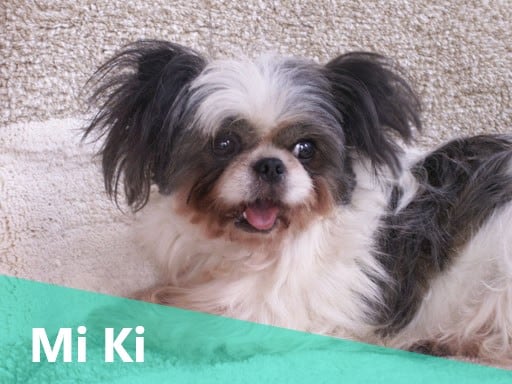In this post:
- Delving Into Its Brief History
- What Does a Miki Dog Look Like?
- Types of Coat & Its Grooming Needs
- Miki Has Easy Going Temperament
- Possible Health Issues
- How to Feed the Miki Dog
- What Are Suitable Living Conditions?
- Training and Exercise
- Pedigree
- Where to Find a Mi-Ki Dog for Sale
- So Is the Miki Your Cup of Tea(cup)?

The Mi-Ki is a small dog breed originating from Wisconsin USA back in the 1980s bred from Mikki Macking. This dog breed is quite rare and relatively at a small size, about 11 inches, weighing around 10 pounds on average. Mi-Ki has a lifespan of 13 to 15 years.
Like me, you may have never heard of a Miki until now. This is because they’re still quite rare.
After recently researching all about the Mi-Ki, I’ve decided that they might be my new favorite toy breed! Let’s see if you feel the same way after getting more acquainted.
Delving Into Its Brief History
Proper documentation wasn’t kept during the development of this breed. So most stories of its origin, are just that, stories.
Original Breeder
Many Mi-Ki enthusiasts will agree that Maureen “Micki” Westburg developed the breed.
Why Was the Miki Name Chosen?
Maureen may have chosen to call the breed the Mi-Ki because this was her nickname.
Others claim the breed was given its name due to it meaning “new beginnings.”
For What Purpose Was the Miki Bred?
Some say Maureen was a fan of the Gremlins, and Ewoks from Star Wars, which were popular in the 1980’s. And for this reason, she wanted to design a dog that resembled these popular characters.
Maureen also wanted the Miki to have a calm demeanor and a quick learning ability. So certain breeds with these characteristics were chosen and used to develop the new perfect companion dog. The Miki is now referred to as the “American Made Purebred.”
What Breeds Were Used to Design the Mi-Ki?

The parent breeds were the Maltese, Papillon, and Japanese Chin.
Theories also state that other breeds like the Yorkshire Terrier, Pomeranian, Pekingese, and Shih Tzu may have been used. But, no one knows if this is true.
Eventually, better records started being kept, and evidence shows breedings between Mi-Ki to Mi-Ki began in the late 1980's. Now there are 15 generations in the history books.
In 1992, testing revealed a specific DNA profile, naming the Mi-Ki, a purebred dog.
What Does a Miki Dog Look Like?
As mentioned above this toy breed dog will be around 10 pounds (25 kg) when it is full-grown. Their height is around 11 inches (28 cm).
Its apple domed head features large dark eyes, and a short, wide muzzle, with a black nose.
Miki’s ears are one of its distinct features as they can move in all directions. Ears can be erect (up), dropped (down) or folded, which is also known as winged.
As a growing puppy, a Miki can have each ear set in a different direction. But once he’s full grown, they will have settled into their permanent position.

Types of Coat & Its Grooming Needs
Mikis come in two different types of coats.
Long Coats (A.K.A. Rough Coats)
This hair is long and straight, with a fine and silky texture, that looks puffy when groomed. They have a lot of hair on the top of their heads, and their face has a beard and a mustache.
Ears have long hair that gives a feathery appearance. Feathered ear hair is something that Papillon mixes like Miki and the Papillon Chihuahua mix share.
Long coats are “hypoallergenic” since they are low or non-shedding. Professional grooming is not necessary. A novice can provide all that a long coat Miki needs.
Smooth Coats
Also known as smooth faces, or smoothies, these dogs have shorter hair and a fox-like appearance. Mikis with smooth coats have short fringing on their ears but don’t sport a beard or mustache.
There’s not much hair on their lower legs. As the Miki matures, they’ll develop some feathering on their lower extremities and feet.
Longish fur is also seen around their mane area.
Smoothies are light shedders, which can be troublesome for allergy sufferers. This type of coat it super easy to groom since it hardly ever mats.
Similarities in Both Coats
Both types have fuzzy, hair filled tails which curve over their back.
All Mikis require regular brushing. With the long coat, it’s needed to avoid mats. As with the short hair, you’ll want to remove any loose hair.
Check out this video for some tips on doing your own grooming:
Variety of Colors
Solid colors are rare. So you should expect your pup to have any combination of the following:
| Apricot | Brown | Red |
| Beige | Chocolate | Sable |
| Black | Fawn | Silver |
| Blue | Gold | Tan |
| Brindle | Mahogany | White |
A Miki’s coat can change color until it settles into what it will be as an adult.
Miki Has Easy Going Temperament
Mi-Kis are intelligent, loving and easy going. Affectionate, playful, yet calm, are other words used to describe this breed.
There’s an elegance about them that will leave you worshiping at their feet.
Miki dogs are protective and always on alert but are unlikely to bark at intruders. Most often, when they’re happy, you’ll hear a yodel or twittering sound.
Mikis love attention and enjoy being around people. As long as you, the owner, approve of new guests, your pup will be friendly to strangers, even children, and other animals.
Their compact size and adaptability make them great sidekicks for your traveling adventures.
Cat Like Tendencies
If you are a cat lover and familiar with their antics, you’ll get a kick out of seeing some of the things a Mi-Ki does.
You may often find them sitting on the window sill, enjoying the scenery and the warmth of the sun.
They even take care of part of their grooming for you, by washing themselves, as a cat would.
Like cats (and its parent breed, the Japanese Chin), they can climb just about anything, including trees.
You’ll also witness the cat-like agility of your Mi-Ki dog. When they play, they like to pounce and swat at their playmates, or toys.
Amazingly enough, in the past, female Mikis have been seen caring for kittens. It’s even said that one dog raised an entire litter which was abandoned! Can you believe it?

Possible Health Issues
Mi-Kis have excess hair between their toes. Keep them trimmed so they'll stay healthy and not collect much dirt.
Hypothyroidism and eyelash disorders can also occur. Fortunately, as of yet, no other specific health problems have been linked to this breed.
Watch out for common issues found in dogs with short muzzles, including respiratory and dental issues. All toy breeds can be affected by health conditions like patellar luxation.
Maintaining proper health will ensure your Miki dog lives out his whole life expectancy of 13 to 15 years.
How to Feed the Miki Dog
Another health concern with toy breeds is hypoglycemia or low blood sugar.
So especially as a puppy, you should feed a dog food for small breeds, that can supply a constant amount of glucose.
You should split their daily amount of food intake into three meals, in order to keep glucose-regulated.
Look at the feeding instructions on your bag of kibble. Use the dog’s weight and activity level as a guide to determine the proper quantity of food you should feed every day.
What Are Suitable Living Conditions?
Since Mi-Kis are so adaptable, they are great for just about anyone.
They can live in condos or apartments. Families in houses with or without yards, singles, or even seniors can also own this dog.
They love having kids and other pets around. But, be sure to supervise small children with Miki’s since they are tiny, fragile creatures. Little humans can be rough on dogs at times. We don’t want anyone getting hurt!

Training and Exercise
Since Mikis are intelligent and eager to please, training isn’t difficult.
Start at an early age and be consistent. Reward your pup with love and treats. A properly trained Miki can make an excellent service or therapy dog.
You can even teach them to use a litter box (just like a cat). This breed does love to run and play so a daily walk will do it well.
Keep in mind that the Mi-Ki dog was bred to be a companion, not an agility dog. So sports won’t be its strong suit. Cuddling with you and looking cute is what it does best.
Pedigree
The breed still hasn’t been recognized by the AKC.
Mi-Ki lovers have developed their own registries. The problem is, among these organizations, they don’t all have the same breed standards.
The UKC only recognizes dogs based on the standards of the International Mi-Ki Registry.
The RVD/UCI registry from Germany has recognized the Mi-Ki Club of America.
Unfortunately, the Continental Mi-Ki Association, nor the American Mi-Ki Club, have not been accepted anywhere else.
It seems logical to me that if the organizations would join forces and agree on one standard, they would be more successful.

Where to Find a Mi-Ki Dog for Sale
With the average litter size only being 1 to 4 puppies, you can imagine why Mikis are hard to find. I’ve managed to locate some breeders for you to check out.
These websites list Miki breeders all over the United States:
- Mi-Ki Breeders USA, Inc.
- International Mi-Ki Registry
More specifically, here are some breeders listed by state:
- California: Brumby’s Run Mi-Kis
- Colorado: Royal T Mi-Kis
- Florida: Elegant Tiny Paws
- Indiana: Little Angels Mikis
- New Jersey: Paddington’s Mi-Kis
- Ohio: Rare Gem Mi-Kis
- Washington State: Belle Amie Mi-Kis
This tiny Miki dog will cost you big bucks. I’ve seen them anywhere from $600 – $2,200 USD.
If rescuing is more in your budget, you visit the American Mi-Ki Club.
Watch the adorable puppies in this video. Their little wagging tails are so cute!
So Is the Miki Your Cup of Tea(cup)?
The Miki dog breed is desirable because it’s highly intelligent, easy to groom, compact and adaptable to many lifestyles.
But being a new breed, I’d be concerned that it may develop potentially serious health issues.
Also, if you’re in search of a specific look, you’ll be taking a risk getting a puppy since their coat color and ears change as they grow.





